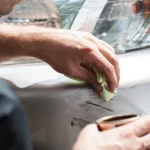How Often Should You Wax Your Car? Seasonal Car Care

Just washing the car with water or a cleaning solution is not enough for protection. Waxing is important to give your car a shiny look and protect it from UV rays and dust. But how often should you wax your car? Read this guide to find out the right frequency of waxing based on different factors.
Table of contents
- The importance of car waxing
- How often you should wax your car
- Benefits of regular waxing
- How does wax protect the paint?
- How Often Should You Wax Your Car? Influencing Factors
- Signs to reapply wax
- Choosing the right wax
- Best waxing techniques
- Conclusion
- FAQs
The importance of car waxing
Waxing your car is like putting a protective layer on the car’s outer surface. It protects your car’s paint and body from UV rays, dust, water, and rust. Without applying the wax, the car’s surface will look dull and more prone to dust particles. Therefore, ensure proper waxing of your car to keep it shiny and protect its paint.
How often you should wax your car
The exact frequency of waxing depends on multiple factors, such as season, climate, and the wax quality. So, how often should you wax your car each season? Here is the detailed answer to the frequency of waxing in each season:
How often should you wax your car in summer?
In summer, the sunlight is very strong and harmful to the car’s paint. Therefore, we recommend you apply wax to your car after washing or once a month. When you wash a ceramic-coated car, the wax is removed from the body. Therefore, whenever you wash the vehicle, you must apply the wax. Moreover, make sure that you know how to wash a ceramic coated car without damage.
How often should you wax your car in winter?
During winter, the roads are mostly covered with salt, snow, and mud. Although the sunlight is not strong enough, you must protect your car from these elements. Therefore, during the winter season, apply wax to your car after 2-3 months to protect it.
How often should you wax your car in spring?
During the spring season, the tree sap falls on your car, especially if you park under trees. Waxing your car at the beginning of spring and then again after 2-3 months helps protect it from these sticky substances. If your car is exposed to tree sap, read our guide on how to remove tree sap from your car without damaging the paint.
How often should you wax your car in the fall?
During the fall seasons, the leaves and debris can produce scratches on your car. Therefore, wax your vehicle at the start of the fall season and then reapply the wax after 3 months. This frequency will keep your car safe from scratches caused by leaves and debris.

These were the frequencies that experts recommend during each season. Please note that whether you wash the car after 1 day, week, or month, you must apply the wax after washing.
Benefits of regular waxing
Regular waxing not only enhances the look of your car but also protects it from UV rays, dust, and other things. Here are some of the common benefits of regular waxing:
1. Reduces minor scratches and swirls
Wax acts like a shield against various environmental damages on the surface of a vehicle. It reduces the appearance of minor scratches and swirls on the paint of your car. Moreover, it also helps hide minor scratches and gives a smooth look to the car.
2. Easier cleaning and maintenance
When you apply the wax to the car, removing the dust and cleaning becomes easy. You can easily remove the dust with a microfiber cloth without producing any scratches.
3. Improves water beading and shedding
When the water falls on the waxed car surface, it is converted into little beads and rolls off easily. It helps prevent water spots and keeps your car looking clean after rain. This way, it also protects your car from rust damage when exposed to moisture.
4. Protects against sun damage
The strong UV rays make your car’s paint look dull over time, especially during hot weather. Proper waxing blocks the UV rays and protects the original color and shine of the car’s paint.

5. Prevents dirt and debris
The dust and debris can easily gather and stick on the rough car surface. Proper waxing makes the car’s surface smooth and prevents the accumulation of dirt and debris. This way, regular waxing plays a key role in keeping the car clean and safe from dirt.
How does wax protect the paint?
Car wax creates a protective layer on the surface of the car’s paint. This layer acts as a barrier to strong UV rays, dust, water, and other harmful substances. Just like the window tint protects the car interior, the wax protects the car exterior. For interior protection, you must choose the right car window tint shades on windows.
How Often Should You Wax Your Car? Influencing Factors
Are you still confused about how often you should wax your vehicle? Take a look at these factors that affect the required frequency of waxing:
1. Exposure to exterior elements
If you mostly park the car in an open area, it is more exposed to UV rays, dirt, and water. In that case, you should wax it more frequently, such as once a week or after every two weeks.
2. Type of wax used
The average lasting duration of the car wax depends on its quality and brand. The natural wax can only last around 2-3 months, but the synthetic wax can last up to 6 months. Therefore, buy the right type of wax based on your needs and the extent of your vehicle usage.

3. Driving and parking conditions
If you park the car in a shady region, the wax will last a long time. In comparison, if you park the car in an open area and under sunlight, the wax will expire shortly. This way, driving and parking habits can greatly affect the average lasting time of wax.
4. Climate and seasonal changes
The frequency of waxing on cars varies in different seasons, as discussed above. Therefore, schedule the waxing of your vehicle based on the climate conditions in your area.
5. Condition of car paint
Another prominent factor is the condition and age of the car’s paint. If the car’s paint is too old or has minor scratches, regular waxing will keep it smooth. Moreover, it will also help to prevent further scratches in the future.
Signs to reapply wax
Regardless of knowing about the right frequency of waxing, there are some signs that indicate a quick need for waxing. Some of the common signs are listed below:
- Water stops beading on the car’s surface.
- The car’s paint looks dull or less shiny.
- The car’s surface feels rough when you run your fingers over it.
Choosing the right wax
Choosing the right wax makes a big difference in the longevity and quality. Synthetic wax lasts longer and provides better protection than natural wax. You can compare and choose the best wax at various online stores for car wax in the USA or other regions.
Best waxing techniques
Here are some of the best techniques to apply wax to a car:
- Using a soft microfiber cloth or foam applicator
- Work in small sections and apply wax to one piece of the car body at a time.
- Apply the wax with the soft cloth in a circular motion.
- After applying the wax, buff the surface with a soft cloth.
- Always wax your car in a shaded area to avoid streaks.

Other than waxing, you can also protect the original paint of a car with vinyl wrapping. Wrapping protects the car’s surface from external damage. If you are planning to wrap the car and want to estimate the required wrapping material, read our guide on how much wrapping you need for your car.
Conclusion
In short, waxing your car makes it look shiny and protects its paint from different elements. Knowing about the right frequency of waxing keeps the car’s paint in perfect condition. The two main factors that affect the frequency of car waxing are weather conditions and the extent of usage.
FAQs
How many times in a year should I wax my car?
Under normal conditions, you should wax your car around 3 to 4 times in a year. On the other hand, in cases of high usage and hot weather conditions, waxing after every month is recommended.
Can I wax my car too often?
Waxing the car too often is not dangerous, but it is just a waste of time and wax. You should stick to the routine based on the weather conditions and driving habits.
Does waxing a car protect against scratches?
Yes, waxing the car protects against minor scratches and swirl marks. Wrapping the car with good vinyl materials is recommended for protection against major scratches.
What happens if I don’t wax the car?
If you don’t wax your car, the paint can become dull and fade over time. The car’s body will get rusted due to rain or moisture in the air. Moreover, the car’s surface will be exposed to damage from sun, dirt, and other environmental factors.
What type of wax is best for my car?
There are several types of car waxes available on the market, and you can choose based on your needs. In general, synthetic wax is long-lasting and provides strong protection, while natural wax does not last long but gives a glossy look.







